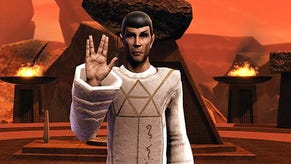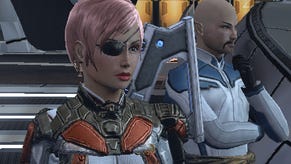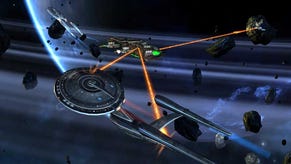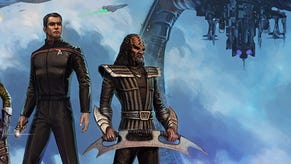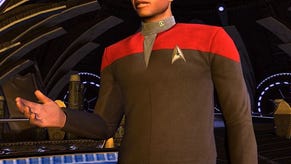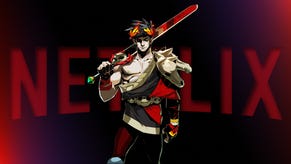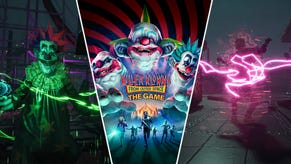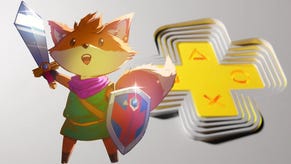Cryptic's Long Trek: Star Trek Online Five Years Later
Five years after a troubled launch, Star Trek Online has finally started to realize some of its original potential.
This article first appeared on USgamer, a partner publication of VG247. Some content, such as this article, has been migrated to VG247 for posterity after USgamer's closure - but it has not been edited or further vetted by the VG247 team.
Last week, I dusted off my Star Trek Online account and logged in for the first time in three years, where I found myself confronted by a harsh reality: I barely had any idea what I was doing.
My screen filled with accolades and status messages as I tried to remember how to fly my ship. The quest status log was loaded with missions that I had accepted back in 2012. And there were the new systems—reputation, fleet contributions, and more, all of them coming on top of a dramatically overhauled user interface. I was Lieutenant Uhura trying to regain her skills after having her mind wiped by Nomad. I was, for all intents and purposes, a beginner. A cadet. A noob.
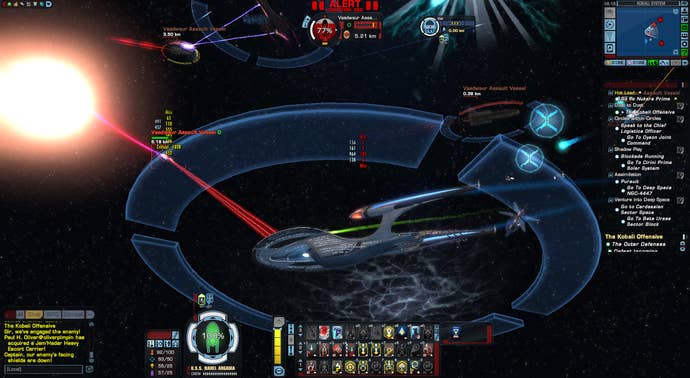
This overhaul may come as a surprise who remember Star Trek Online as the sad and rather barren MMO that launched in 2010 with a surfeit of bugs and almost no endgame to speak of; but since then, Cryptic has been working quietly behind the scenes to make their trek through the stars one worth taking. The past five years have brought with them a large number of high-quality missions, many more ships, a new faction, and guest appearances by the likes of Michael Dorn (Worf), Garrett Wang (Harry Kim), Denise Crosby (Tasha Yar, Sela). Within the past year, they've released the Delta Rising expansion, which opens Star Trek Voyager's Delta Quadrant while raising the level cap for the first time since launch.
Given all of that, it's fair to say that Star Trek Online has survived and even thrived to a degree outside of the public eye. But unfairly or not, Star Trek Online's improvements have gone mostly unnoticed, overshadowed by its poor reputation and other, more popular MMORPGs. After all these years, though, there's still not a lot like it. And that's why I'm back in for the first time since 2012, feeling like Scotty aboard the Enterprise-D.
Perpetual Struggles
Star Trek Online has existed in one form or another since at least 2004, when Perpetual Entertainment commenced work on an MMORPG set in Gene Roddenberry's universe.
A few years before, Ultima Online and EverQuest had kicked off a gold rush among developers eager to capitalize on the concept of persistent online worlds. Star Wars Galaxies launched in 2003, with World of WarCraft following in 2004 and Lord of the Rings Online appearing in 2007. Star Trek's still formidable popularity made it an obvious candidate for an MMORPG, and Perpetual Entertainment obliged, with speculation being that a beta version would be available by 2006.
Suffice it to say, that did not happen. Instead, Perpetual disintegrated in 2007 and the rights to Star Trek Online went to Cryptic, who had earned praise for their work on the popular superhero MMO City of Heroes. Comparatively little is known about Perpetual's plans for Star Trek Online, but there was talk of large starships like the Enterprise-E serving as hubs, with players controlling small ships and shuttles. A few months ago, Massively posted an article detailing the rise and fall of Perpetual, which goes into more detail.
With only two years to push a full-formed Star Trek MMORPG onto the market, Cryptic went into overdrive. Perpetual's plans were scrapped, with Cryptic deciding instead to make every player a starship captain; a decision derided by some critics and praised by others. They also shifted the balance away from exploration and diplomacy and more toward action by putting the Klingons and the Federation at odds once again.
The game that emerged had notably strong space combat, but not much else. Leaving your beautifully rendered starship and venturing down to a planet typically meant boring missions that involved fighting waves of enemies while your NPC crewmembers fell all over one another. Crafting was cumbersome, raids were non-existent, and the Klingon faction was almost entirely limited to player-versus-player arenas. Cryptic made it to retail before deadline, but the game they put out was more or less unfinished.
Reviews were accordingly unforgiving. Reviewing Star Trek Online for Eurogamer, Oli Welsh wrote at the time, "Players are miserable, and Klingon chat channels are among the most dispiriting places to hang out on the internet right now. This faction will need to get some serious love if it's to foster a community healthy enough to provide the happy hordes of Starfleet with proper competition."
I also reviewed Star Trek Online when it first arrived in 2010, and while my own review has since vanished into the ether, my recollections are much the same. Cryptic had done their best, but Star Trek Online was a mess; and once you hit the level cap, there was almost nothing to do. As a result, interest dropped sharply not long after.
That might have been that but for the starship combat. Built on the premise of knocking out an enemy's facing shields with phasers and finishing them with torpedoes, it was twitchier and more interesting than the standard MMO fare, as well as faithful to the look and feel of the show. The combat was what stuck with me long after I had moved on to other games. And in the end, it was what helped draw me back in two years later.
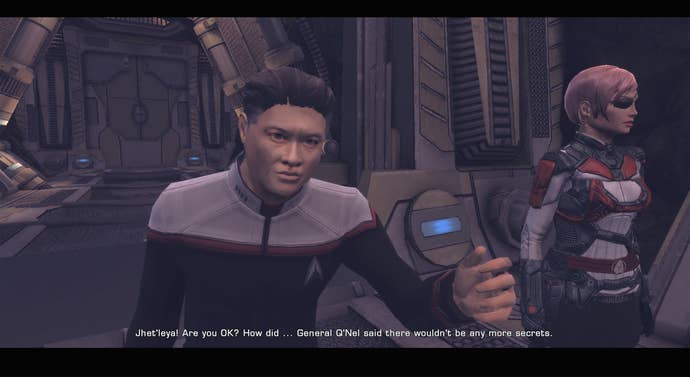
"Did you hear? Star Trek Online is good now."
I heard many variations on that theme through 2011. Crytic had worked hard to address many of Star Trek Online's quality of life issues, revamping the the UI, releasing new content for the Klingon faction, and introducing elite loot sets. My interest was piqued, but I mostly filed it away as something to check out at a later date.
In early 2012, Star Trek Online went free-to-play, and I used the opportunity to jump in to see what had changed. The answer: Pretty much everything. The graphics had been improved, there were far more missions to play, and the design was much cleaner; but the crown jewel was the Duty Officer system. Reminiscent of a similar mechanic in Assassin's Creed Brotherhood, it made it possible to collect crewmembers with varying skillsets and send them on missions, the completion of which brought in money and experience. It wasn't quite a replacement for "exploring strange new worlds," but its inclusion at least made it feel as if there was more to Star Trek Online than phasers, torpedoes, and more phasers.
After a while, I started to become attached to my "DOFFS," as they were referred to in-game, despite their lack of backstories and personalities. The random Ferengi, Klingon, and Vulcan crewmembers lent a sense of diversity to my crew, fostering the sense that I was in fact in charge of a large and powerful vessel. There were also the random event DOFFs like the clone of Dr. Sibak, who could be obtained in the mission "Hearts and Minds," available during Friday the 13th and Halloween. I don't know why, but there's something precious about the idea of a clone of a mad scientist working hand-in-hand with Vulcans, Jem'Hadar, and the odd liberated Borg.
Being unemployed at the time and with not much else to do, I dove headfirst into Star Trek Online's content, eventually racking up more than 200 hours of playtime. Along the way, I was dragged into the still-limited PvP, where I met a friendly clan known as the "Sad Pandas" and began to discover just how deep Star Trek Online's rabbit hole really went.
At the time, the Sad Pandas were one the game's best PvP clans. Flying in their tricked out ships, they would queue up together for the arenas and annihilate unsuspecting pickup groups or "PuGs," which is how I ran into them for the first time. Along with the rest of Star Trek Online's clans, they had managed to decode the game's rather arcane systems and maximize their damage output, enabling them to rip through lesser ships like tissue paper.
It was through them that I learned the secret to keeping weapons power at maximum at all times, keeping my shields up, and delivering an effective "alpha strike"—MMO parlance for a crushing attack that delivers a massive amount of damage in a short time. When a battle would begin, their little Defiants would zoom out to engage while I would lumber behind in my big Odyssey cruiser, regenerating health and soaking up as much damage as possible. When the word came over Ventrilo, the team's science ship would drop a crippling debuff, three tractor beams would lock onto the designated target, and dozens of phaser blasts and torpedoes would rip through their shields. It was like art.
Fun as these sessions were though, many of the conversations were tinged with frustration. In their push to build up the PvE (player-versus-environment) content, Cryptic had largely neglected the PvP, and many players felt that the developers had been too indiscriminate with their balance changes. As time went on, it became increasingly clear that PvP simply wasn't a priority for Cryptic, and many players grew frustrated and moved on.
Three years on, not much has changed, unfortunately. In my conversation with senior producer Stephen Ricossa for this piece, I asked about the status of Star Trek Online's PvP, and his response echoed a common refrain from my time spent with the Sad Pandas, "PvP is a feature we’ve talked about a lot over the years. In general, we would rather take time to do it right than quickly pull something together. Upgrading our PvP system is something the team would really like to do, and we'll continue to consider it as we plan our regular updates."
Alas, we're still waiting.
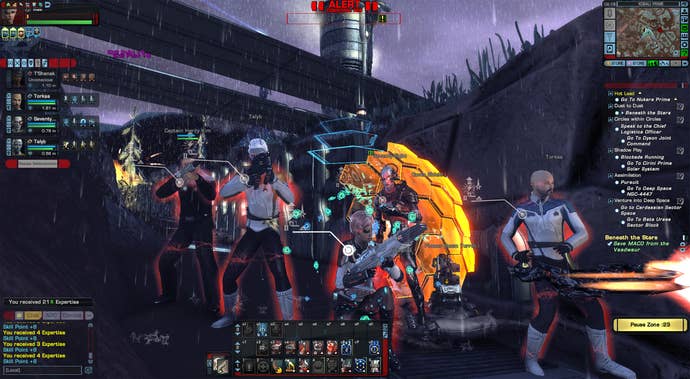
As will happen with pretty much any MMORPG, I eventually hit the content wall with Star Trek Online. I had most of the best gear and a stable of high-quality ships, and I had finished all of the missions. I drifted away, resolving to come back once there was more content.
You know how it is, though. You dig into some other games, you lose touch with the community; and eventually, you lose the thread entirely and start to forget what you were doing in the first place. Thus my disorientation when I finally returned after a three year absence, compounded by the many changes to the interface. I've got most of the systems figured out now, but it's a bit like coming home after living in another country for a few years to find that the roads are completely different and all the shops have changed.
Impressively, Star Trek Online's production values have continued to rise while I've been away. Their fifth year anniversary episode guest starring Garrett Wang is one of their most impressive efforts to date. Teamed with Captain Harry Kim, you have to fight your way through the trenches of a warzone, sneak through a series of electrical barriers, and negotiate a lengthy maze. There are even branching paths delineated by difficulty level. When compared to the launch content, which mostly featured a series of boring cube-like chambers and faceless mobs, it feels like a completely different game.
Since I last played in 2012, Cryptic has produced hours of content like this, each one a self-contained mini-episode of Star Trek with multiple objectives. Even now it pales in comparison to the likes of World of WarCraft; but at this point, Star Trek Online has enough pure story content covering almost every series and movie to last at least 80 hours, all of it for free.
Ricossa is understandably proud of the team's work. "As we left the launch era of content creation, we pushed to add more depth to the gameplay and to the story. We first created the concept of a featured episode series, which spanned several weeks and told one continuous story. Although the featured episodes have evolved from that original form, they continue to be some of the most in-depth stories we tell. We added class-specific objectives, integrated cutscene technology, introduced elements of randomization that change each playthrough of an episode, added celebrity voice actors, and expanded our story arcs over months instead of weeks. The story content we create now represents the best work we’ve ever produced, and we'll continue to push the envelope so that always remains true."
The rest of the game has been built out as well. Player-controlled fleets can contribute to the construction of a private starbase with a variety of amenities and unique missions, which Ricossa refers to as one of his favorite developments along with the revamped tutorials since the game's launch.
"There are so many fun and engaging systems in STO, but these represent first endgame system and a revamp of the first content everyone plays, so they all hold a special place for me," he wrote.
I've dabbled in a little bit of everything since getting back. I've worked my way through the anniversary episode, watching Ensign Kim become a Kobali and trying to parse out how past Kim can be dead while future Kim can be alive before remembering that it's Star Trek Voyager and giving up. I've taken on an entertaining, and surprisingly difficult, multi-part starbase raid that mercifully doesn't feature the Borg, the de fact endgame enemy to this point. And I've started building up toward the new level cap, in the process unlocking ship masteries and new character traits, both of which have been implemented at some point in the past couple years.
Of course, no discussion of a free-to-play MMORPG is complete without a look at the microtransactions underpinning its business model. Mercifully, all of Star Trek Online's core content is free, and the basic ships (which include vessels in the class of the Enterprise-D, Enterprise-E, Voyager, and Defiant) are all capable of holding their own. With the right gear, the Assault Cruiser can even be quite powerful, though your mileage will vary on the design (I've never been a big fan of the Enterprise-E).
Which is not to say that Star Trek Online avoids in-game purchases entirely. There's quite a large selection of ships to choose from in the Cryptic store, most of them very powerful. I'll admit that I ended up spending a money on an Odyssey cruiser, rationalizing the purchase by telling myself that had gotten more than my money's worth out of the free content. Cryptic also sells in-game items, uniforms, increased inventory space, and a variety of other knick-knacks, the majority of which don't have a large impact on the game. It is entirely possible to enjoy Star Trek Online without spending a dime.
Having said that, Cryptic is not entirely guiltless. Top-end ships like the Assault Cruiser Refit can cost as much as $25, which is, to put it lightly, way too much. Cryptic also likes to push lockboxes that have a chance to yield an ultra rare ship with the use of a key, which can be purchased for a dollar. These ships can usually be purchased via the player exhange, but they will run you millions of credits. Alternatively, you can refine dilithium and use it to buy keys (or ships) from the store, but the process is again quite time consuming. Ultimately, it's possible to live without such items, and Cryptic has softened the blow of wasting money on a lockbox by having it yield yet another currency—lobi crystals—that can be used to buy special items. But despite that, lockboxes continue to represent microtransactions at their most onerous.
Having said all that, though, my overriding impression of Star Trek Online is of an MMO that has ripened with time. The messy and confusing menu screens are gone now, replaced by slick-looking pop-ups and intuitive signposting; and a good chunk of the best original content has been totally revamped, bringing with them perks like in-engine cutscenes and more intricate objectives. The microtransactions are irritating, but they can be safely ignored. In total, it is a slick, rather entertaining little starship MMO. Finally, more than a decade after its initial conception, Star Trek Online has managed to realize a glimmer of its original promise.

Looking ahead to the future, it's tough to imagine where Cryptic will take the canon next. Star Trek Online has covered the franchise from almost every angle, even giving the likes of Star Trek V and Star Trek: Nemesis their day in the sun. Just as an example, the fifth year anniversary episode draws from a comparatively obscure episode of Star Trek Voyager, and features a race that hasn't been seen since. At this point, having brought in everything from the Guardian of Forever to the 200 missing Dominion ships from Star Trek: Deep Space Nine, Cryptic is digging pretty deep.
Naturally, Ricossa is confident the team will find more material. Star Trek, after all, has been around for a very long time. "There are still significant portions of the Delta Quadrant that we haven't touched, and the entire Gamma Quadrant is available to us. What we like to do is take inspiration from a Star Trek episode or movie, and then expand on it in our own way. You can find some nugget of Trek lore in pretty much every episode we’ve released, which is really exciting for us and for the players."
Beyond that, Cryptic has addressed huge number of complaints and requests from launch, but there's always more that can be done. The PvP is still very much wanting, the factions are heavily unbalanced toward the Federation, and there's that whole "exploring strange new worlds" thing, which has been mostly neglected amid all of the action.
These past few years have been a strange and at times infuriating ride as I've dealt with the reality of bugs, content gaps, and lockboxes; but looking at Star Trek Online in its totality, I'm impressed by what Cryptic has accomplished. From a dismal launch, they've managed to make an MMO that comes closer than I might have thought possible to capturing the spirit of Trek, with more to come. As they say at the end of Star Trek III: "The adventure continues."



